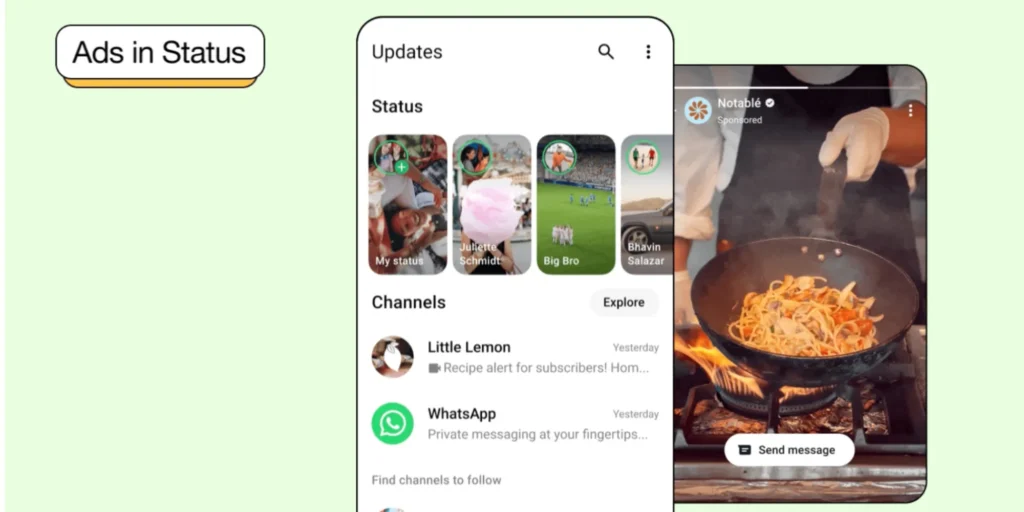In a significant shift from its original ad-free promise, WhatsApp has finally introduced its first major advertising features in 2025. This move marks a new chapter for the messaging giant, which has traditionally focused on privacy and simplicity. As Meta (formerly Facebook) looks to further monetize the platform, the latest update brings in new tools and features designed to help businesses engage with users more effectively — all while ensuring that users’ experience is not overly disrupted.
This blog breaks down everything you need to know about the new WhatsApp feature, how businesses can use it, and what it means for everyday users.
A Brief History of WhatsApp’s Stance on Advertising
Since its launch in 2009, WhatsApp built its reputation on being an ad-free, secure messaging service. Founders Jan Koum and Brian Acton were vocal critics of ad-based business models. Even after being acquired by Facebook in 2014 for $19 billion, WhatsApp remained relatively ad-free. However, over the years, subtle changes hinted that the platform would eventually integrate commercial features.
By 2018, the WhatsApp Business app was launched, offering basic tools for businesses to interact with customers. In 2021, WhatsApp introduced catalog features and click-to-chat ads on Facebook and Instagram. But now, in 2025, the company has finally taken a bold step forward with WhatsApp introducing full-fledged advertising tools within the app itself.

What Is the New WhatsApp Advertising Feature?
The newly introduced advertising feature allows businesses to display sponsored messages in select sections of the app. These are not the traditional banner ads you see on websites but are integrated into the WhatsApp Business experience in a subtle and non-intrusive way.
There are three major advertising tools that WhatsApp introduced:

- Sponsored Chat Promotions
Businesses can now promote products or services through sponsored messages that appear at the top of a user’s chat list. These messages are labeled clearly and appear only if a user has interacted with the brand in the past or opted in through the business’s website or ad campaigns. - Status Ads (Beta)
A small group of users is now seeing ads in Status. Much like Instagram Stories ads, these short, skippable ads allow businesses to show products, offers, or services. This feature is still being tested but is expected to roll out globally by the end of the year. - Click-to-WhatsApp Ads with Insights
Businesses running click-to-ads on Facebook and Instagram now get more detailed insights. With this, Meta is fully integrating the advertising ecosystem, making WhatsApp a more powerful platform for business conversions.
How Does This Affect Users?
The WhatsApp advertising feature is designed to keep the user experience at the forefront. Regular users will not see random ads while chatting with friends or family. All sponsored messages are either permission-based or triggered by interactions with businesses.
Here’s what you can expect as a user:
- No ads in personal chats: Your private messages remain unaffected.
- Sponsored messages only appear if you’ve interacted with a brand or opted into updates.
- Ads in Status can be skipped and are marked as promotional content.
- Privacy controls will let users manage which businesses can send them sponsored messages.
So, while WhatsApp introduces advertising, it still tries to balance monetization with privacy and user satisfaction.

Benefits for Businesses
This new WhatsApp feature opens the door for businesses to create more engaging and direct marketing campaigns. Unlike emails that get lost in spam or SMSs that go unread, WhatsApp messages have a 98% open rate. That’s a goldmine for marketers.
Here’s how businesses can benefit:
- Higher visibility with sponsored messages at the top of the chat list.
- Better targeting thanks to integration with Meta’s ad tools.
- Improved insights to measure ROI on WhatsApp campaigns.
- Seamless customer interaction, from click-to-chat to product catalog and checkout.
For small businesses, this could be a game-changer, allowing them to market directly without the need for expensive ad platforms.
Concerns and Criticism
Despite its benefits, the move has sparked debate. Many long-time users worry that the charm of WhatsApp — its clean, ad-free interface — might be lost. Privacy advocates are also cautious, wondering whether this signals deeper integration of user data across Meta’s platforms.
Critics argue:
- This may lead to more intrusive marketing in the future.
- The line between private and promotional content could blur.
- User data sharing with advertisers may increase despite assurances of encryption.
However, WhatsApp has reiterated that end-to-end encryption remains untouched and that ad targeting is based only on user-business interactions, not on private conversations.
Future Roadmap – What WhatsApp Plans Next
As WhatsApp introduces these new features, the roadmap suggests more automation and commerce-friendly updates are on the way. Rumors indicate that Meta may roll out:
- AI-powered business assistants within WhatsApp chats.
- In-app payment promotions to boost WhatsApp Pay.
- Verified business badges for improved trust.
With over 2.8 billion users globally, WhatsApp is strategically positioning itself not just as a chat platform, but a commerce hub for the next generation of mobile users.
Final Thoughts
The fact that WhatsApp introduces advertising tools marks a historic shift in the app’s evolution. While some users might be skeptical, the initial rollout appears carefully designed to preserve the platform’s integrity. Whether you’re a marketer looking for new ways to connect or a user curious about what’s changing, this WhatsApp feature is one to watch.
As we move further into 2025, one thing is clear: WhatsApp is no longer just a messaging app — it’s becoming a dynamic platform where communication, commerce, and now, advertising converge.




